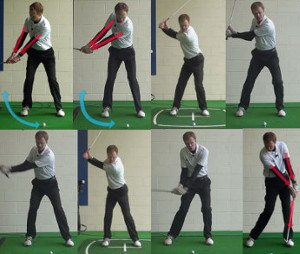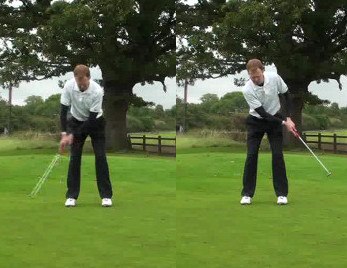Once you discover that your balance is a problem, there is only one thing to do – take action. You should get to work on improving your balance right away, as the sooner you correct this problem, the sooner you can play better golf.
The good news is this – improving your balance during the golf swing doesn’t have to be a daunting task. Like so many other things in golf, this challenge is best overcome by keeping things simple. Work on basic fundamentals, pay attention to the small details, and start with soft swings before working your way up to the driver. By making balance a priority during practice, you can make consistent progress until you have developed a well-grounded, solid swinging action.

Do you dream of striking the ball solidly time after time, with every club in your bag? If that’s the goal that keeps you up at night as a golfer, you will want to focus closely on your balance. Learning to stay balanced throughout the swing is a huge step in the right direction when quality ball striking is the goal. There are plenty of other technical elements that need to come together in a successful swing, but it all starts with balance. Learn how to control your weight during the swing and you might be surprised to find how easy solid ball striking can be.
With this article, we’d like to cover the topic of balance from top to bottom. This is a big topic, to be sure, so we’ll break it down into a variety of sections. First, we are going to talk about why balance is important. This section should give you all the motivation you need to get down to work on this part of your game. From there, we are going to go over some common balance issues, and we’ll also get into a couple of practice drills you can use to iron out any issues you are having. Lastly, the matter of balance in the short game will be covered, as it is just as important there as it is in the full swing.
All of the content below is based on a right-handed golfer. If you happen to play golf left handed, please take a moment to reverse the directions as necessary.
— The Value of Balance in Golf
You have probably heard it said before that you need to be balanced while you make your golf swing. But do you know why? What is it about balance that is going to make you a better player? Having specific benefits in mind when practicing should motivate you to stick with it through the tough moments. It’s never easy to improve in this game, so it’s always a good idea to understand what’s waiting for you on the other side when those breakthroughs finally arrive.
Let’s highlight a few key ways that your game can benefit from reliable balance.

| GOLF FIXES BY PGA PROS |
|---|
| Firing The Golf Club Down To Target With Balance | Video | Article |
| Fixing Your Balance To Avoid Golf Topped Shots | Video | Article |
| Check Your Balance To Stop Pop Up Golf Tee Shots | Video | Article |
| Correct Your Body Balance For Improved Swing Results | Video | Article |
| Staying Balance In Your Golf Swing | Video | Article |
| Hold The End Of The Golf Swing To Create Better Balance | Video | Article |
| Step Towards Improving Your Golf Balance | Video | Article |
| Hold the End of the Golf Swing to Create Better Balance | Video | Article |
| Three Ways To Lose Your Golf Balance | Video | Article |
| Correct poor balance by holding your finish | Video | Article |
| Balance And Weight Is Key When Moving The Golf Ball Back | Video | Article |
| LESSONS |
|---|
| Balance And Rhythm In The Golf Short Game | Video | Article |
| Best Fundamentals for Proper Golf Balance | Video | Article |
| Get The Correct Golf Swing Sequence To Improve Balance | Video | Article |
| Solving The Balance Equation In Your Golf Swing | Video | Article |
| Good Balance Is Essential In A Good Golf Swing | Video | Article |
| Golf Swing Starts With Balance | Video | Article |
| Head Position Balance And The Bottom Of The Golf Swing | Video | Article |
| The Powerful Duo Of Balance And Rhythm Can Change Your Golf Game | Video | Article |
| The Balance Needed for Long Clubs | Video | Article |
| Balance And Rhythm In The Golf Short Game | Video | Article |
| How To Improve Your Swing Balance Techniques | Video | Article |
| Top 4 Tips On Correct Golfer Balance | Video | Article |
| Balance In A Proper Golf Swing | Video | Article |
| It Is A Matter Of Balance With 80 Percent Golf Driver Swings | Video | Article |
| Using Balance To Understand If Your Golf Swing Sequence Is Correct | Video | Article |
| Check Your Current Golf Balance | Video | Article |
| Justin Rose: Right Knee Stays Flexed for Balance, Power | Video | Article |
| Swing Balance A to Z Series | Video | Article |
| Correct Poor Balance By Holding Your Golf Finish Position | Video | Article |
| Maintaining Balance And Rhythm For 18 Golf Holes | Video | Article |
| Element 1- Balance | Video | Article |
| Ensure A Smooth Rhythm To Ensure Good Golf Swing Balance | Video | Article |
| PRACTICE DRILLS |
|---|
| Reverse The Swing Drill To Correct Golf Balance | Video | Article |
| Rushing In Your Golf Swing It Can Cause Balance Problems | Video | Article |
| Golf Drill Tip: Stop pushing – Maintain balance | Video | Article |
| It Is All About Balance With Push Problem | Video | Article |
| The Helpful Balance Drill To Control Your Center Of Gravity | Video | Article |
| Monitoring Your Balance Whilst Making A Full Golf Swing Turn | Video | Article |
| GOLF QUESTIONS |
|---|
| Why Do I Fall Off Balance After My Golf Shots? | Video | Article |
| GOLF EXERCISES |
|---|
| Single Leg, Single Arm Deadlift For Balance And Power During The Swing | Video | Article |
| Golf Bicep Balance Exercise | Video | Article |
| Golf Shoulder Press Balance Exercise | Video | Article |
| Golf Weight Shift Balance | Video | Article |
| Leg Extension Golf Balance Exercise | Video | Article |
| One Leg Shoulder Raise For Golf Balance | Video | Article |
| Resistance Band FliCross Over For Golf Body Balance | Video | Article |
- Clean ball striking. The ability to strike the ball cleanly at the bottom of the swing is one of the most important skills in golf. When you hit the ball cleanly, you will be more likely to hit it the correct distance for the shot at hand. Also, you should have an easier time controlling the trajectory and direction of the shot – making you more accurate in the end. Good balance makes you a better ball striker because it allows you to properly predict where the bottom of your swing arc will be. If you are moving significantly from side to side as you swing, the bottom of your arc is going to move as well. That makes it hard to line up the bottom of the swing with the location of the ball, meaning you will miss-hit plenty of your shots. By stabilizing your swing, you’ll be more consistent with the placement of the bottom of the swing arc, and you’ll start to hit the ball much cleaner.
- Ability to swing harder. That’s right – good balance can actually provide you with the freedom to swing harder, which is something that most golfers love to hear. It’s fun to hit the ball a long distance, especially off the tee, but only if that ball is traveling in the right direction. When you are balanced, it will be easier to keep the club on track through the hitting area while giving it plenty of speed. Players who are off balance are usually fighting so hard to keep the club in position that they are unable to really turn it loose and maximize their distance potential. For many players, the problem stems from wanting to swing hard first and then work on their mechanical issues later. If you take the opposite approach – dialing in your balance and making sure your fundamentals are solid – you should be able to ramp up the speed from there without much trouble.
- Ball flight options. When playing from an off-balance position, you may only be able to create one kind of ball flight. For instance, if you tend to hang back on your right side during the downswing, leaning away from the target, you are likely to produce high shots. Even if you manage to become consistent with those high shots, you won’t have the flexibility to do anything else. So, when a situation arises where you need to produce a low shot, you’ll be out of luck. If you can learn to swing the club with excellent balance, more options are going to open up to you down the line. You’ll have the opportunity to learn how to hit the ball both high and low, depending on the circumstances, and you might even get comfortable with using a draw and fade on command. To become a well-rounded golfer who isn’t limited to just one type of shot, prioritize your balance during practice.
- Perform under pressure. One of the biggest challenges in golf is trying to hit quality shots under pressure. With some practice and a bit of coordination, it’s not too hard to hit at least a few decent shots down the range, or down the fairway on an open golf course with no one around. However, the nature of this game is such that it gets much tougher when you add in a bit of pressure. By paying close attention to your balance as you work on your technique, you will be putting a solid base in place that is going to serve you well when you start to feel nervous on the course. Good balance doesn’t mean that you will be immune to pressure, of course, but it will help you deal with it more effectively. Basically, by swinging with good balance, you will be limiting the number of things that can go wrong during your swing. And, under pressure, limiting how many things can go wrong is a very valuable step to take.
Simply put, there is a ton to gain by learning how to swing the golf club in a balanced fashion. Will you immediately start hitting every fairway and green once you improve your balance. Nope – but you will gradually become a better player. With your balance under control, you should be able to work on other parts of your technique with confidence, knowing your balance won’t be holding you back from reaching the goals you have in your sights.
— Common Balance Problems
There are a few balance problems that are seen over and over again across the game of golf. These mistakes are easy to make, which is why so many amateur golfers seem to run into trouble with them both on the range and on the course. By highlighting the problems that many golfers have with balance, we hope to help you take a close look at your issues. Are you making any of the errors below? If so, work on a solution right away so your game can move forward without any limitations.

- Sliding toward the target. This is an error that is seen all over the game of golf. Countless amateur players believe that they need to ‘shift their weight’ toward the target during the downswing. This belief leads them to slide their weight to the left early in the downswing, moving their center of gravity way out over the left foot. The problems with this mistake are numerous. For one thing, when the lower body slides to the left, the upper body is naturally going to hang back to the right to compensate. Your right shoulder will drop and there is a good chance you will hit the ball fat. Even if that doesn’t happen, you’ll have a hard time releasing the club properly, meaning your shots may hang out to the right and they won’t have much power, either. All in all, sliding toward the target is a huge mistake that is going to make it almost impossible to reach your potential. Learn to rotate toward the target rather than sliding and you may open up a whole new world of possibilities on the course.
- Swinging too hard. Trying to swing the club too hard is a classic golf mistake. And, of course, it’s easy to understand why this happens. Golfers want to hit the ball a long distance, and it seems like swinging as hard as possible is the right way to work toward that goal. In reality, there is a lot more to hitting long shots than just swinging hard. You need to use efficient mechanics to accelerate the club, you need to make contact as close to the center of the face as possible, and you need to manage your ball flight/trajectory. By swinging as hard as you can, you’ll struggle to maintain balance, which will in turn make it harder to do things like make solid contact and control your ball flight. One of the best practice drills you can do at the driving range is to simply make some soft swings and see how far the ball will go when you make good contact. You might be surprised to find that even gentle swings can send the ball rather impressive distances when you execute everything else properly. On the course, you don’t have to swing soft, but you shouldn’t be swinging as hard as possible, either. Manage the amount of effort you put into each swing, so you can make it easier to stay on balance.
- Poor address position. Sometimes, your balance will be doomed right from the start of the swing. If you don’t take a solid stance over the ball at address, it’s going to be hard to keep your balance all the way through the swing and into the finish – even if you do everything else right. At address, sit down into your stance by using plenty of knee flex while keeping your back relatively straight. Then, tilt forward from the hips to provide yourself the room necessary to make a free swing back and through. Consider taking some time at home to practice taking your stance in front of a mirror without a club. The more repetitions you can log getting in and out of your stance, the easier it will be to repeat that position on the range, and then on the course.
- Too long in the backswing. This one is a close cousin of swinging too hard, but we needed to give it its own point to highlight the dangers of this mistake. When trying to hit the ball a long distance, you might swing as hard as possible from start to finish – or you may just turn back as far as you can in an effort to make plenty of room and build speed that way. And, it is true that a long backswing can provide you with space and help you create speed. However, if you turn back too far, you are likely to lose your balance and struggle to hit good shots. One of the tricky things about finding the right backswing length is that it will be different from player to player. Some golfers are naturally able to make a longer backswing than others, so don’t try to compare yourself to anyone else when working on your backswing length. Find a backswing that allows you to strike a nice balance between building power and staying on balance.
Don’t be too hard on yourself if you are currently making one or more of the mistakes listed above. These are extremely common errors, so keep your head up and get to work on finding solutions that will get you on track.
— Simple Golf Balance Drills
It’s easy to head to the driving range and feel a little bit lost as to what you should do to improve your game. Just making the same faulty swing over and over again isn’t helping anything – and it might even make your problems worse to reinforcing those bad habits. This is where golf practice drills come into the picture. By using drills – in this case, drills designed to help improve your balance – you can make strides and start to see real progress from one session to the next.
Below, we have listed two simple balance drills that you should consider testing out during an upcoming range session.

- Narrow stance swings. This is a great drill to help you get control over the length and level of effort in your swing. The idea itself is very simple – stand with your feet very close together and make some practice swings on the range. You aren’t going to hit any shots with this drill. You’ll just pick a club – a mid-iron works well – and make some swings back and forth. Start slow and gradually pick up the speed as you go but pay close attention to your balance. When you start to feel yourself losing balance, slow back down and make sure the swing isn’t getting too quick or too long. When you are done with the drill, move your feet back out to their normal position and make some more swings. You may be surprised to find just how solid your stance feels at its regular width after logging some swings from a narrow stance.
- Triple pause. This is another drill that won’t actually have you hitting any shots. For this drill, you are again going to make practice swings, and again a short iron is a great choice for the club you’ll use. However, this time, you are going to use your standard stance width, but you’ll be pausing three different times in the swing. So, take your stance as if you are going to hit a normal shot on the course. Start the swing and pause yourself when the club reaches parallel to the ground on the way back. Hold this position for a moment, then continue up to the top of the swing where you will pause again. Hold that position for a moment, then swing down through and into a full finish. Hold your full finish for a few seconds before starting over. What’s the point of all this? Simple – you want to check to see that you are still balanced at each of these three ‘checkpoints’. If you don’t feel yourself leaning awkwardly in any given direction when you pause your swing, you must be doing a pretty good job of staying balanced. Keep this drill in mind and use it anytime you feel that your balance is starting to get off track.
There is nothing complicated about the two balance drills above. They are quick, easy to perform, and require no special equipment beyond what is already in your golf bag. Give one or both of these drills a try during your next range session and see what they can do for your balance.
— Mastering Short Game Balance
It probably goes without saying that keeping your balance in the short game is much easier than doing the same thing in the long game. After all, you aren’t making big swings in the short game, so you won’t be nearly as likely to be pulled off balance in one direction or another. However, with that said, you don’t have to make big balance mistakes when chipping or putting to run into trouble. Even a minor loss of balance can cause your shot to be a disappointment. The points below should help you work on your balance in this vital area of the game.

- Strong address position is still important. Just as was the case when setting up to hit a full shot, you need to have a good address position in the short game if you want to stay balanced. And, many of the same tips still apply – bend from the knees, tilt forward from the waist with your back straight, and keep your chin up away from your chest. When chipping from an awkward lie, be sure to take an extra moment to get comfortable in your stance before hitting the shot.
- Keep your eyes still. Believe it or not, the movement of your eyes can impact your balance while trying to hit a short game shot. Once you are set in your address position and are ready to swing, focus your eyes on a spot on the golf ball and leave them there until the shot is on its way. It’s always tempting to move your eyes early, usually because you want to look up and see where the ball is going to go. One of the best things you can do in practice is work on breaking that bad habit. Train yourself to keep your eyes on the ball until it has been sent on its way. This habit might be a tough one to break but doing so can greatly benefit your short game results.
- Hold your finish. Make it a point to hold your finish until the ball is most of the way, or all of the way, to the hole. If you start coming up out of your stance as soon as you have hit the shot, that habit might lead to instances where you come out of the stance even before contact has been made. Don’t let yourself go down that road. Hold your position well after the ball has left the club and let that serve as a constant reminder of how important balance is to your overall short game.
Making improved balance one of your top golf goals is a great way to move toward lower scores. Countless amateur golfers struggle with their balance, and the results show on the course. Playing from a balanced position is going to open up many new possibilities, and you may find that you can attempt shots while balanced that would have been impossible otherwise. Good luck!







